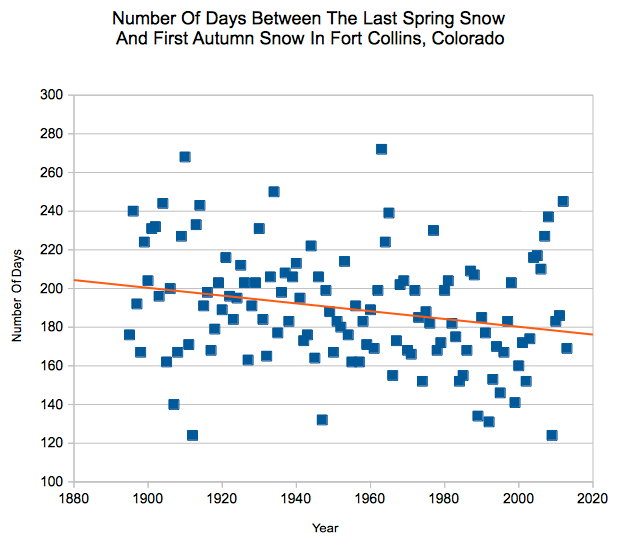In the late 19th century Fort Collins averaged about 200 days between the last spring snow and the first autumn snow, but summer is almost a month shorter now.
Disrupting the Borg is expensive and time consuming!
Google Search
-
Recent Posts
- New Visitech Features
- Ice-Free Arctic By 2014
- Debt-Free US Treasury Forecast
- Analyzing Big City Crime (Part 2)
- Analyzing Big City Crime
- UK Migration Caused By Global Warming
- Climate Attribution In Greece
- “Brown: ’50 days to save world'”
- The Catastrophic Influence of Bovine Methane Emissions on Extraterrestrial Climate Patterns
- Posting On X
- Seventeen Years Of Fun
- The Importance Of Good Tools
- Temperature Shifts At Blue Hill, MA
- CO2²
- Time Of Observation Bias
- Climate Scamming For Profit
- Climate Scamming For Profit
- Back To The Future
- “records going back to 1961”
- Analyzing Rainfall At Asheville
- Historical Weather Analysis With Visitech
- “American Summers Are Starting to Feel Like Winter”
- Joker And Midnight Toker
- Cheering Crowds
- Understanding Flood Mechanisms
Recent Comments
- Stuart Hamish on New Visitech Features
- Stuart Hamish on New Visitech Features
- Disillusioned on Ice-Free Arctic By 2014
- Disillusioned on Ice-Free Arctic By 2014
- Disillusioned on Ice-Free Arctic By 2014
- conrad ziefle on Ice-Free Arctic By 2014
- conrad ziefle on Ice-Free Arctic By 2014
- Jack the Insider on Ice-Free Arctic By 2014
- Bob G on Ice-Free Arctic By 2014
- Bob G on Ice-Free Arctic By 2014



I love snow – just not that much!
That’s a lot of scatter and you can’t have snow without enough water vapour, but certainly no sign of the climate getting warmer. I lived in Ft Collins in the 80’s. Looks like I picked a cold period. I remember one snow thunderstorm in May, which until I experienced it, never thought could happen.
How do first and last frosts track?
Very entertaining site by the way. Thanks.